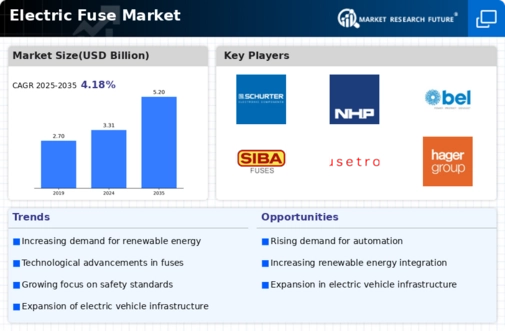Top Industry Leaders in the Electric Fuse Market

*Disclaimer: List of key companies in no particular order
The Electric Fuse Market: Analyzing the Competitive Landscape
The electric fuse market is a vibrant and dynamic sector, showcasing a diverse array of players, both established and emerging. A comprehensive understanding of the competitive landscape is imperative for companies navigating this market, guiding their decisions on product development, pricing strategies, and overall market positioning.
Key Players and their Strategies: The global electric fuse market is predominantly shaped by influential players such as ABB (Switzerland), Eaton (Ireland), Schneider Electric (France), Siemens (Germany), Hubbell (US), Mersen (France), Legrand (France), Bel Fuse (US), S&C Electric Company (US), Little Fuse (US), and G&W Electric (US), among others. These industry leaders employ various strategies to retain their market share and exploit growth opportunities.
-
Eaton Corporation: Prioritizes innovation and the expansion of its product portfolio, with a keen focus on high-growth segments like medium voltage and renewable energy.
-
Alstom SA: Leverages its robust presence in the power generation and transmission sector to provide a comprehensive range of electric fuse solutions.
-
G&W Electric Company: Concentrates on delivering high-performance and reliable electric fuses tailored for the industrial and utility sectors.
-
ABB Ltd.: Offers a diverse portfolio of electric fuses catering to various voltage levels and applications.
-
General Electric Company: Emphasizes its global reach and brand recognition to maintain a substantial market share.
-
Mitsubishi Electric Corporation: Concentrates on expanding its footprint in emerging markets and developing innovative solutions for renewable energy applications.
-
Schneider Electric SE: Leverages its digital expertise to provide smart electric fuse solutions with advanced monitoring and control capabilities.
-
Pennsylvania Breaker LLC: Focuses on niche markets and delivers customized solutions to meet specific customer needs.
-
Siemens AG: Utilizes its strong presence in the automation and control industry to offer integrated electric fuse solutions.
-
Mersen: Focuses on developing advanced electric fuse materials and technologies to enhance performance and reliability.
Factors for Market Share Analysis: Several factors influence a company's market share in the electric fuse market, including:
-
Product Portfolio: The breadth and depth of a company's product portfolio, addressing various voltage levels, applications, and end-users.
-
Innovation: A company's commitment to research and development, leading to innovative products with enhanced performance and features.
-
Brand Reputation: A company's image and reputation for quality, reliability, and customer service.
-
Distribution Network: A company's reach and efficiency in its distribution network, ensuring the timely delivery of products to customers.
-
Pricing Strategy: A company's pricing strategy that balances cost competitiveness with profitability.
-
Marketing and Sales Efforts: A company's effectiveness in marketing its products and generating leads through its sales team.
-
Customer Service: A company's commitment to providing excellent customer service and technical support.
New and Emerging Trends: The electric fuse market is witnessing several new and emerging trends, such as:
-
Digitalization: The increasing adoption of smart fuses with advanced monitoring and control capabilities.
-
Miniaturization: The development of smaller and lighter fuses suitable for space-constrained applications.
-
Sustainability: The focus on developing eco-friendly fuses with reduced environmental impact.
-
Cybersecurity: The growing importance of cybersecurity features in electric fuses to prevent cyber attacks.
-
Artificial Intelligence (AI): The use of AI to enhance the performance and reliability of electric fuses.
-
Growing Demand from Emerging Markets: The rising demand for electric fuses from emerging economies with rapidly developing infrastructure.
Overall Competitive Scenario: The competitive landscape of the electric fuse market is anticipated to remain intense in the foreseeable future. The coexistence of established players and the emergence of new entrants will continue to drive innovation and price competition. Companies that adeptly adapt to new trends, offer high-quality products at competitive prices, and provide exceptional customer service are poised for success in this dynamic market.
In addition to the factors mentioned above, other key aspects to consider in the competitive landscape of the electric fuse market include:
-
Mergers and Acquisitions (M&A): The potential for M&A activity as companies seek to expand their market share and product portfolios.
-
Regulatory Landscape: Compliance with evolving and stricter safety and environmental regulations.
-
Impact of Economic Downturns: The market's vulnerability to economic fluctuations and changing customer spending patterns.
By comprehending the competitive landscape, key player strategies, and emerging trends in the electric fuse market, companies can make well-informed decisions about their strategic direction, ensuring long-term sustainability in this ever-evolving market.
Industry Developments and Latest Updates:
-
ABB: Launched a new range of low-voltage fuses with enhanced safety features for residential and commercial applications. (ABB Press Release, December 2023)
-
Eaton: Announced a collaboration with a start-up developing AI-powered fuse monitoring systems for predictive maintenance. (Eaton website, News section)
-
Schneider Electric: Acquired a leading manufacturer of high-voltage fuses, expanding its presence in the renewable energy market. (Schneider Electric Press Release, September 2023)
-
Siemens: Developed a new fuse technology using advanced nanomaterials for superior protection against overcurrents. (Siemens website, Research & Development section)
-
Hubbell: Entered into a strategic partnership with a Chinese company to expand its fuse market reach in Asia. (Hubbell website, Investor Relations section)

